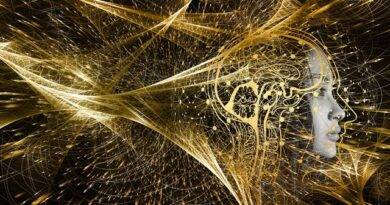Air Traffic Controllers: The Indispensable Linchpins of Aviation Safety
Imagine navigating a sky crowded with airplanes, ensuring each one reaches its destination safely and on time. This is the daily reality for air traffic controllers (ATCs), the unsung heroes of aviation. Working in control towers, radar rooms, and area control centers, ATCs play a pivotal role in managing air traffic flow, coordinating takeoffs, landings, and in-flight navigation. Their precision and quick decision-making skills are vital to maintaining the safety and efficiency of air travel, making them indispensable to the aviation industry.
Air traffic controllers are key professionals in aviation. Who are they, where do they work, and what do they do? While control towers at airports are familiar landmarks, most controllers operate in radar approach or area control centers. Let’s explore their world in detail.
Introduction to Air Traffic Controllers
Who are air traffic controllers (ATCs)? ATCs are ground-based aviation professionals responsible for the safe and efficient operation of aircraft within designated airspace, such as TMA (Terminal Maneuvering Area) and FIR (Flight Information Region).
Using advanced Voice Communication Systems, ATCs communicate with pilots to provide essential instructions and guidance, ensuring flight safety and efficiency.
ATC operations are divided into three main units: Control Towers, Radar Approach Control, and Area Control Centers (also known as En-route Control in some regions). Let’s delve into each unit’s role and responsibilities.
Control Tower, ATC Tower, Aerodrome Control Tower
Air Traffic Control (ATC) Towers are iconic structures located at airports, serving as critical hubs for managing ground and air operations. Tower Controllers are responsible for overseeing activities in the aprons, taxiways, runways, and the aerodrome vicinity (Control Tower Region or CTR). Their duties include issuing landing and takeoff clearances, flight plan approvals, and start-up and push-back instructions. They also manage taxiing traffic to ensure smooth ground operations.
Below is a simple aerodrome chart illustrating taxiing traffic patterns and the layout of an airport’s ground control areas.
- Control Tower Responsibilities:
- Landing and Takeoff Clearances: Ensuring safe sequencing of aircraft movements.
- Flight Plan Clearances: Verifying and authorizing flight plans before departure.
- Start-up and Push-back Clearances: Coordinating aircraft movements from gates to taxiways.
- Communication Systems:
- Voice Communication Systems: Used for real-time communication between ATCs and pilots.
- Safety Measures:
- Monitoring Airspace: Ensuring no conflicts in the immediate airport environment.
- Emergency Protocols: Handling unexpected situations like equipment failures or adverse weather conditions.
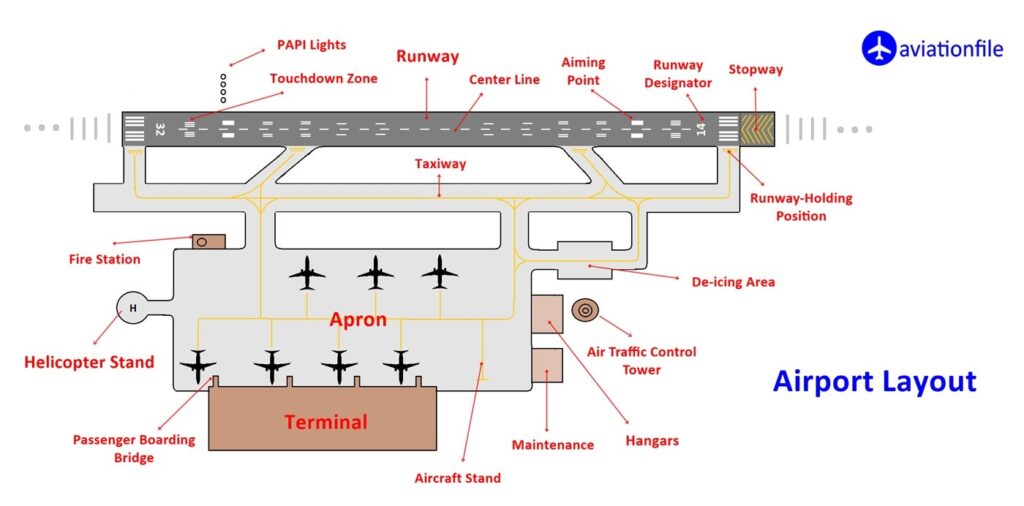
Imagine possible seperations and traffic load on a complex Airport like JFK.
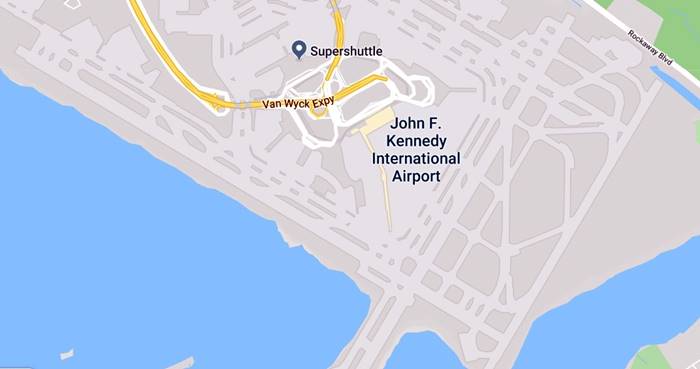
Vicinity of an Aerodrome
To manage aircraft in the vicinity of an aerodrome, traffic patterns are established for active runways. These patterns ensure a safe and efficient flow of air traffic. Tower controllers and pilots use aviation language and English to communicate and adhere to these patterns.
For example, if you are flying in the “Right hand downwind leg for runway 19R,” you would see the runway on your right. This adherence to traffic patterns is crucial for maintaining order and safety.
Below is an example of a typical traffic pattern.
- Traffic Pattern Elements:
- Downwind Leg: Parallel to the runway, opposite direction of landing.
- Base Leg: Perpendicular to the runway, preparing for final approach.
- Final Approach: Aligning with the runway for landing.
- Communication Protocols:
- Standardized Phrases: Ensuring clear and concise communication.
- Real-time Updates: Adjusting traffic flow as necessary for safety.
- Safety and Efficiency:
- Sequencing Aircraft: Avoiding conflicts and maintaining orderly traffic.
- Emergency Handling: Quickly adapting patterns for emergencies.
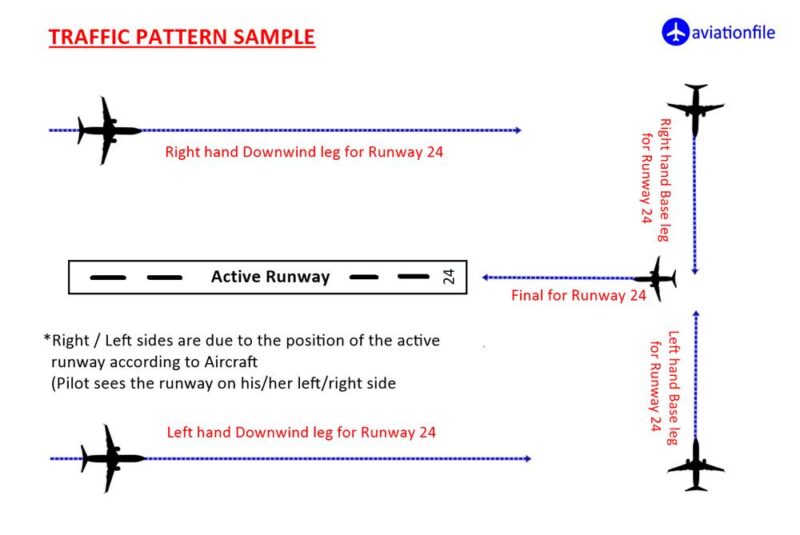
RADAR APPROACH AND DEPARTURE CONTROL
In radar control units, air traffic controllers work in an office environment, monitoring and managing air traffic using radar screens and Voice Communication Systems (VCS) to communicate with pilots. By observing aircraft movements on radar, ATCs provide necessary instructions and advice to ensure safe and orderly traffic flow.
ATCs employ vectoring techniques, issue climb and descend orders, and enforce speed restrictions to maintain safe separation between aircraft. The radar screen displays aircraft as colored labels, each representing a different flight.
- Vectoring Techniques:
- Directing Aircraft: Guiding aircraft to specific headings for optimal routing.
- Altitude and Speed Management:
- Climb and Descend Orders: Managing aircraft altitude to ensure safe vertical separation.
- Speed Restrictions: Controlling aircraft speed to prevent conflicts.
- Safety Protocols:
- Conflict Resolution: Quickly adjusting aircraft paths to avoid potential collisions.
- Emergency Handling: Providing immediate instructions during in-flight emergencies.
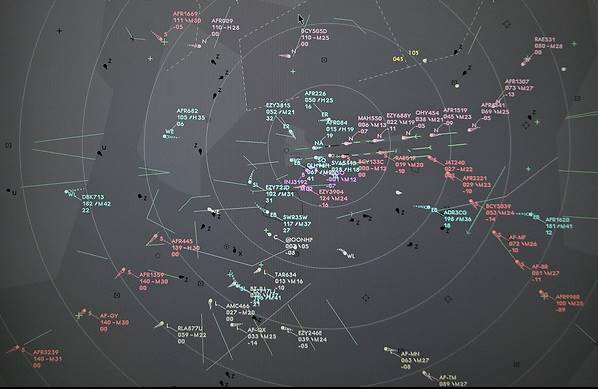
Area Control Center, En-Route Control Center
In en-route control units, ATCs operate similarly to those in radar approach and departure units. They work in front of radar screens and communicate with pilots, but their primary responsibility is managing aircraft during the cruise phase of flight. Controllers monitor flights within their designated control area, a part of the Flight Information Region (FIR), ensuring safe separation and efficient routing.
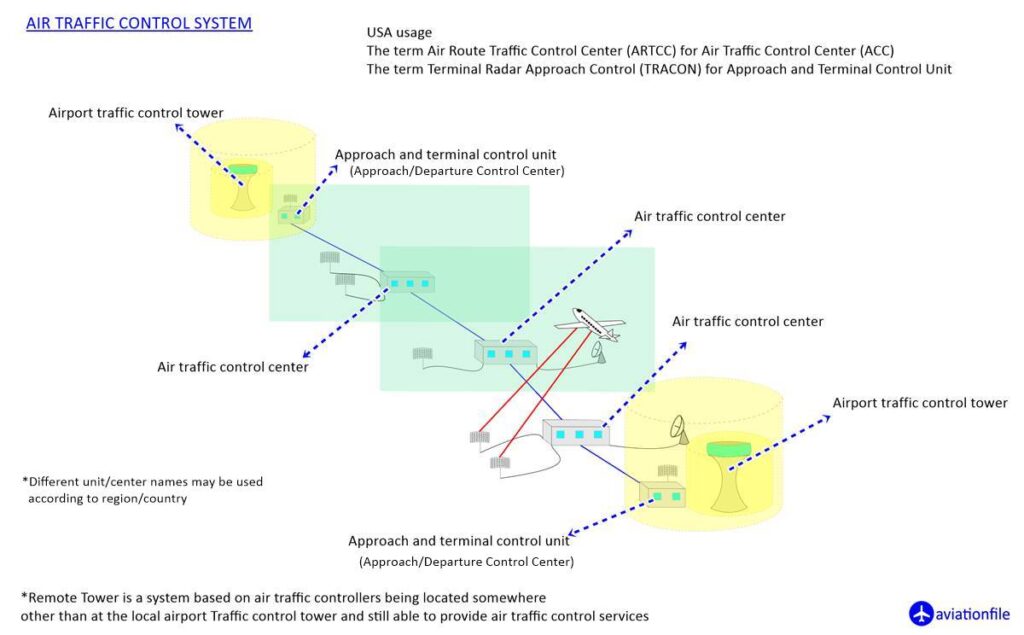
Here is a screenshot of area over Germany from Flightradar24.
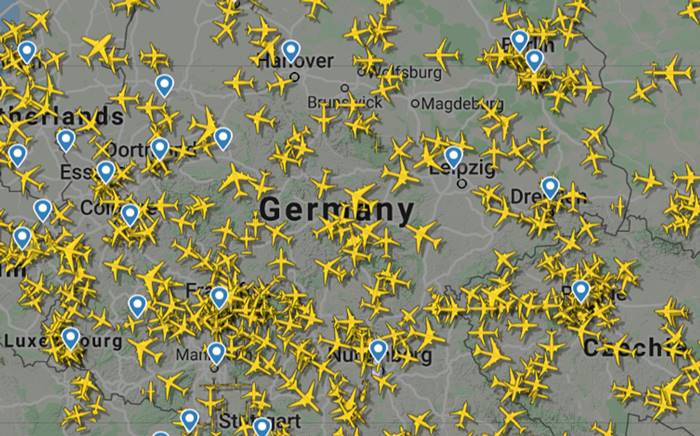
Why Air Traffic Controllers are Indispensable
Air Traffic Controllers are the unsung heroes of the aviation industry. Their meticulous work prevents mid-air collisions, minimizes delays, and keeps the skies safe for thousands of passengers and crew every day. They are the backbone of a smooth-running air traffic control system, the invisible foundation that allows modern air travel to function flawlessly.
In conclusion, it is fair to say that ATC controls the traffic in a defined airspace with proper methods. First aim is to maintain the safety standards and then efficient flow of air traffic.
According to some researches, being an Air Traffic Controller is one of the most stressful jobs ever. Click for ILO work paper on ATC occupational conditions.
Further Reading on Air Traffic Controllers (ATC)
For a deeper dive into the world of Air Traffic Control, here are some credible resources:
- U.S. Bureau of Labor Statistics: Air Traffic Controllers https://www.bls.gov/ooh/transportation-and-material-moving/air-traffic-controllers.htm
- Federal Aviation Administration (FAA): Air Traffic Careers https://www.faa.gov/air_traffic
- National Air Traffic Controllers Association (NATCA) https://www.natca.org/
For more Articles click


